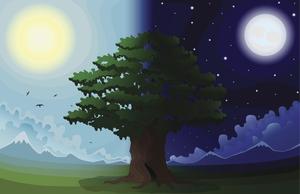Glossary term: 地軸
Description: 地軸是一條假想的直線,地球每天圍繞它旋轉一圈。地軸與地球表面相交的兩個位置是地理北極(北緯 90°)和地理南極(南緯 90°)。與此相對,赤道也是一條假想線,是垂直於地軸的平面與地球表面相交的大圓,與地軸的距離最遠。赤道的緯度為 0°。
地理南北極與地球磁場南北極的位置不同--磁極定義為地球表面上地磁場方向豎直向上和豎直向下的點。
地球公轉軌道也有一個軸:方向與地球軌道平面垂直。地軸與軌道軸夾角 23.4°。這一夾角是地球四季變化的原因。特別是,在一個軌道週期中,北半球或南半球會向太陽傾斜,從而接收到更多的光。
相對於最遙遠的天體,地軸指向的方向會隨著時間的推移而緩慢變化,這就是所謂的歲差(地軸近動)。目前,地軸與天球相交的位置接近北極星。但在大約 2.6 萬年的時間裡,這個交點會在天空中畫出一個小圓圈。以地球為參照定義的天球坐標系需要考慮到由此產生的隨時間推移的微小坐標偏移。
Related Terms:
See this term in other languages
Term and definition status: The original definition of this term in English have been approved by a research astronomer and a teacher The translation of this term and its definition is still awaiting approval
This is an automated transliteration of the simplified Chinese translation of this term
The OAE Multilingual Glossary is a project of the IAU Office of Astronomy for Education (OAE) in collaboration with the IAU Office of Astronomy Outreach (OAO). The terms and definitions were chosen, written and reviewed by a collective effort from the OAE, the OAE Centers and Nodes, the OAE National Astronomy Education Coordinators (NAECs) and other volunteers. You can find a full list of credits here. All glossary terms and their definitions are released under a Creative Commons CC BY-4.0 license and should be credited to "IAU OAE".
If you notice a factual or translation error in this glossary term or definition then please get in touch.
Related Activities
Why Do We Have Day and Night?
astroEDU educational activity (links to astroEDU website) Description: Explore day and night of Earth.
License: CC-BY-4.0 Creative Commons 姓名標示 4.0 國際 (CC BY 4.0) icons
Tags:
Tilt
Age Ranges:
6-8
, 8-10
, 10-12
Education Level:
Primary
, Secondary
Areas of Learning:
Modelling
, Structured-inquiry learning
, Social Research
Costs:
Low Cost
Duration:
1 hour 30 mins
Group Size:
Group
Skills:
Asking questions
, Communicating information









